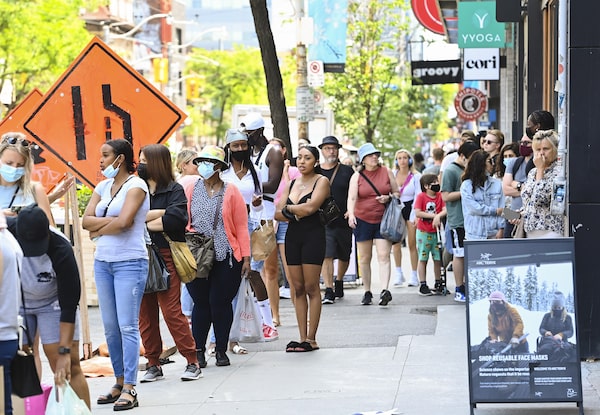
People shop and wait in long lines to enter stores along Queen Street West during the COVID-19 pandemic in downtown Toronto on June 11, 2021.Nathan Denette/The Canadian Press
It is a hot summer morning on West Queen West and the popular strip of Queen Street in downtown Toronto is brimming with urban life.
A skateboarder in a backward baseball cap zips by. A young buck with a six-pack of bottled beer heads for the park with a buddy. A tall woman in a short dress and tiny purse totters along the sidewalk, looking slightly uncertain about walking on high heels after the year of the flip-flop. Another woman sports green cowboy boots and carries a matching concoction of healthful and no-doubt-expensive juices.
Women getting their fingers and toes attended to in a newly reopened nail salon watch through a plate-glass window as the world passes by outside: buses, cyclists, rollerbladers, dog walkers with pandemic puppies, parents with strollers, food-delivery dudes with boxy backpacks. Almost no one wears a mask.
From the way it feels in many Canadian cities these days, the pandemic is over. It isn’t, of course – not quite yet. The Delta variant still threatens. Millions of Canadians are still not fully vaccinated. Health authorities warn that we must still take care and follow the rules.
And yet what a long way we’ve come. Just a few short weeks ago, the third wave was rolling across the country. Hospital emergency wards were flooded. Intensive care units were maxed out. Exhausted doctors and nurses were struggling to cope with the onslaught.
All that is a receding memory now. The numbers in ERs and ICUs are down dramatically, and so are new COVID-19 cases. This week, for the first time in nine months, Ontario had a day with no new deaths from the virus.
Vaccination rates have soared. Once lagging other countries for jabs given, Canada is now one of the leaders, with around 70 per cent of the population partly vaccinated and around 40 per cent fully. In Toronto, as of this week, more than half of residents have had two doses.
The results are visible all around, and what a sight it is. Those brilliant new curb-lane patios that sprouted on Toronto’s main streets during the pandemic are filling up with smiling people. The parks, bike paths and waterfront walking trails teem with summer traffic. Even Canada’s Wonderland, the giant amusement park in Toronto’s north, is open again.
More is to come as lockdowns ease: bigger gatherings, more sports and music events, more people allowed in stores. Restaurants in Toronto are preparing to welcome customers for indoor dining. The CN Tower and its revolving restaurant are getting ready to open for business. So is the long-shuttered Royal Ontario Museum. The Art Gallery of Ontario will reopen with a blockbuster Andy Warhol exhibit.
All those reports on the death of the city as we knew it turned out to be greatly exaggerated. The pandemic killed countless businesses, threw many people out of work and subjected even healthy residents to an isolation that many found punishing. Yet cities stand to bounce back stronger than ever.
The pandemic taught us how much we crave the human connection that is best found in dense and busy cities. Though many of us will continue to work remotely, and some will mix working from home and the office, urban downtowns are already hopping again.
The pandemic taught us that streets belong to people as much as cars. Bike lanes and traffic-calming measures have proliferated over the past year. Those curbside patios and car-free weekend zones have been a huge success. More, please.
The pandemic taught us we can make a difference on chronic issues such as homelessness. Toronto has housed thousands in temporary and semi-permanent accommodations. That work should continue.
The pandemic taught us that, as successfully multicultural and welcoming as they are, our cities have troubling inequities that showed up in the heavy toll that the virus exacted on less privileged neighbourhoods. It took a massive outreach effort in those areas by vaccination and other health teams to start bridging those gaps. That work must go on, too.
But what the pandemic taught us above all is that we need each other. Cities are where people come together – to work, to create, to achieve, to mingle, or just to walk along the sidewalk in green cowboy boots. It’s wonderful to see them coming back to life.
Our Morning Update and Evening Update newsletters are written by Globe editors, giving you a concise summary of the day’s most important headlines. Sign up today.
 Marcus Gee
Marcus Gee